Sour and astringent are two kinds of taste in wine. The acid comes from the organic acid substances in the wine, while the astringent taste comes from the tannins in the wine.
1. Why is wine sour?
The acidity of wine comes from a variety of organic acids in the wine, including natural acids such as Tartaric Acid and Malic Acid, which are more irritating, and Succinic Acid and Citric Acid (Succinic Acid) Citric Acid), and softer lactic acid (Lactic Acid).
What factors affect wine acidity?
The level of wine acidity is affected by the characteristics of wine grape varieties, the climate of the producing area and the brewing process. Wines made from different grape varieties have different acidities. Therefore, consumers should choose wines with different acidities according to their own tastes when purchasing wine. For example, among white grape varieties, Riesling, Chenin Blanc and Sauvignon Blanc have high acidity, while Viognier and Gewurztraminer have low acidity; , Italian red grape varieties such as Nebbiolo or Barbera are very high in acidity, while grape varieties from warm regions such as Grenache are very low in acidity.
The climate of a grape-growing region also affects the acidity of the wine it produces. Take Chardonnay as an example. Wines from the cool-climate Burgundy Chablis generally have crisp, crisp, high acidity, while wines from the warm-climate California have less acidity. are generally lower and softer.
In addition to the above natural factors, the level of wine acidity is also related to the winemaking process. If the winemaker uses malolactic fermentation (Malolactic Fermentation), the sharp malic acid in the wine will be converted into softer lactic acid, and the overall acidity of the wine will also decrease.
Acid, what is the important role?
Acidity is the soul of wine, which makes every wine show strong vitality. First of all, acid can preserve and inhibit bacteria, and support the aging of wine; it is like a preservative, which can slow down the oxidation rate of wine, balance the microbiome, inhibit the growth of harmful bacteria, and thus help aging.
Secondly, acid can balance the taste; if the acidity is too low, the wine will be monotonous and boring, and if the acidity is too high, it will cover the flavor and texture of the wine, making the taste of the wine too sharp, and the appropriate acidity can bring freshness and crispness to the wine. It also stimulates the taste buds to better experience the texture and flavor of the wine.
Finally, acid also maintains the color of red wine; in general, the higher the acidity of the wine, the more stable the color and the deeper the red color.
2. Astringency in wine
Since wine is made from grapes or grape juice, the tannins in wine are also associated with the grape fruit itself. That’s right, tannin is a secondary metabolite widely present in the composition of plants (grape skins, grape seeds, grape stems, etc.).
The so-called secondary metabolites refer to some material components that are not necessary for plant survival or development, but are products in the face of external environmental stress, most of which have a protective effect on the plant itself. This effect is reflected in tannins, which may refer to their antibacterial and antioxidant properties, and even have a certain biological inhibitory effect on tiny animals that harass plants.
If there are no tannins in the wine
The astringency that wine brings to the mouth is mainly caused by tannins, and this astringency often also arouses another kind of taste association—bitterness. Since the substance doesn’t feel good, why not just filter out all the tannins from the wine? This is because the oxidative delay of tannins plays an important role in the wine’s ability to age. A bottle of high-quality red wine with natural tannins in a harmonious proportion can often gradually enter the best drinking period after several years or even decades.
In fact, if you don’t like astringent red wine with tannins, you can choose to drink white wine. Because in the brewing process of white wine, winemakers will choose a brewing sequence that is popular with people who are not familiar with red wine-first press and filter and then ferment, that is, almost entirely use the components of grape pulp that people eat to ferment into wine.
appreciate tannins
Unlike the brewing process of white wine, the juice with alcoholic components is squeezed out after the fermentation is completed during the brewing process of red wine. The maceration during on-skin fermentation extracts the tannins from the skins into the juice, along with the pigments that give the wine its red color. Although tannin is a taste component that needs to be adapted to people who do not have a tradition of drinking red wine, but for people who drink red wine regularly, this non-toxic, harmless and even healthy antioxidant organic component is an important ingredient for wine. The framework has been established, that is, taste appreciation should not just stop at the instant enjoyment of feasting. On a refreshed level, tannins also bring to the mouth a kind of frictional resistance that represents the future and lasts for a long time-after slow oxidation and fusion, the taste that will be improved to a higher level can still be expected.
In addition to the content and texture level of tannin itself, whether tannin is in harmony with other material components in wine is also a very important indicator for judging the value of tannin. For example, the balance between tannins and acids is particularly important. The tannin content of red wine should be directly proportional to the acidity of the wine, and there should be enough fruit to support it, so as to achieve a perfect balance.
Post time: Mar-13-2023

